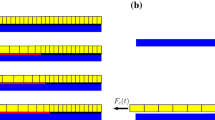An algorithm for solving the problem of slow growth of a mode I crack with a zone of partial contact of the faces is proposed. The algorithm is based on a crack model with a cohesive zone, an iterative method of finding a solution for the elastic opening displacement, and elasto–viscoelastic analogy, which makes it possible to describe the time-dependent opening displacement in Boltzmann–Volterra form. A deformation criterion with a constant critical opening displacement and cohesive strength during quasistatic crack growth is used. The algorithm was numerically illustrated for tensile loading at infinity and two concentrated forces symmetric about the crack line that cause the crack faces to contact. When the crack propagates, the contact zone disappears and its dynamic growth begins.
Similar content being viewed by others
References
M. P. Savruk, Two-Dimensional Elasticity Problems for Cracked Bodies [in Russian], Naukova Dumka, Kyiv (1981).
G. P. Cherepanov, Mechanics of Brittle Fracture [in Russian], Nauka, Moscow (1974).
A. N. Guz, “On physically incorrect results in fracture mechanics,” Int. Appl. Mech., 45, No. 10, 1041–1051 (2009).
A. A. Kaminsky, “Mechanics of the delayed fracture of viscoelastic bodies with cracks: Theory and experiment (review),” Int. Appl. Mech., 50, No. 5, 485–548 (2014).
A. A. Kaminsky and E. E. Kurchakov, “Influence of tension along a mode I crack in an elastic body on the formation of a nonlinear zone,” Int. Appl. Mech., 51, No. 2, 130–148 (2015).
A. A. Kaminsky, M. F. Selivanov, and Yu. A. Chernoivan, “Subcritical growth of a mode III crack in a viscoelastic composite body,” Int. Appl. Mech., 49, No. 3, 293–302 (2013).
W. G. Knauss, “A review of fracture in viscoelastic materials,” Int. J. Fract., 196, 99–146 (2015).
R. A. Shapery, “Time-dependent fracture: continuum aspects of crack growth,” in: M. B. Bever (ed.), Encyclopedia of Materials Science and Engineering, Pergamon Press, New York (1986), pp. 5043–5053.
L. I. Slepyan, Models and Phenomena in Fracture Mechanics, Springer, Heidelberg (2002).
J. G. Williams, Fracture Mechanics of Polymers, Wiley, New York (1984).
Author information
Authors and Affiliations
Corresponding author
Additional information
Translated from Prikladnaya Mekhanika, Vol. 53, No. 6, pp. 16–22, November–December, 2017.
Rights and permissions
About this article
Cite this article
Selivanov, M.F. Slow Growth of a Crack with Contacting Faces in a Viscoelastic Body. Int Appl Mech 53, 617–622 (2017). https://doi.org/10.1007/s10778-018-0844-8
Received:
Published:
Issue Date:
DOI: https://doi.org/10.1007/s10778-018-0844-8




